Paper Menu >>
Journal Menu >>
 Journal of Environmental Protection, 2011, 2, 124-129 doi:10.4236/jep.2011.22014 Published Online April 2011 (http://www.SciRP.org/journal/jep) Copyright © 2011 SciRes. JEP Polluter-Pays Principle Applied to Construction and Demolition Debris Manfred Fehr1, Rogério Borges Marques2, Alessandra Fernandes Nascimento Pereira3 Institute of Geography, Federal University at Uberlândia, Uberlândia, Brazil. Email: prosec22@yahoo.com, rogeriobmarques@yahoo.com.br, alessandrafernape@gmail.com Received October 21st, 2010; revised November 21st, 2010; accepted December 28th, 2010. ABSTRACT The research focused on the analysis o f constructio n and de molition debris in a samp le Brazilian city with the objective to propose a management scheme tailored to private initiative intervention. The debris was found to be produced at a rate of 1.55 kg per person per day for a total of 5177 tons per month. The composition report showed 75% material reusable for construction purposes, 15% material recyclable through reverse logistics and 10% refuse to be disposed of at landfills. The study developed legal and managerial instruments that stimulate private operators to achieve landfill diversions in the order of 90% of this waste. The arguments were supported by a flow diagram that indicates the correct destination of all waste items and an economic balance of private waste movement. Proactive legal scriptures were sketched out that can assist the local administration in setting the timeframe for reach ing th e diversion target. Keywords: Brazil, Construction and Demolition Waste, Landfill Diversion, Private Waste Enterprise, Proactive Legislation, Reverse Logistics, Waste Management, Waste Market 1. Introduction The Johannesburg Summit of 2002 defined the sanitation target as follows: halve by 2015 the proportion of people without access to proper sanitation [1]. The practical re- sults of international ag reements such as this one depend on the ability of national and local administrations to provide the necessary legal framework for implementa- tion. This is the fundamental argument of the present study. It proposes to create thinking models that face the future at local levels through proactive legislation. Apart from supporting the directives passed down by the Jo- hannesburg Summit and possible future similar events, proactive laws go beyond compliance. Th ey are dynamic instruments, which contain provisions for constant up- dating and take into account changing social and envi- ronmental situations such as population growth and re- source limitations. The arguments are applied specifi- cally to construction debris, with the declared objective to reduce landfill space. Sustainable urban development is advocated in Brazil by the Law of the Cities, which obliges municipal ad- ministrations to edit and apply directives for the protec- tion of the environment [2]. Part of this obligation refers to the correct treatment and disposal of solid waste in- cluding construction and demolition debris (CDD). A report by Azevedo et al. [3] describes the problems en- countered with CDD in the City of Salvador, Brazil and identifies some basic management strategies. The argu- ment relies on source separation of all CDD followed by correct destination of all components. The shortcoming in this, as in many other proposals analyzed by the au- thors, resides in the absence of legal measures to make the source separation mandatory and of a practical model for debris movement and treatment that includes private initiatives. This is not an exclusively Brazilian problem. Other countries and regions experience the same type of challenge. Examples of legislation pertaining to CDD may be found in the USA [4], in N ew Zealand [5] and in Europe [6]. Proactive legal scriptures have been used by various government bodies in various parts of the world [7-19]. The present study assimilates all those experiences and develops proactive waste management strategies for the Brazilian context, based on data collected in a sample town. Starting from present practice of tipping all debris at a dumpsite provided and operated by the municipal administration, the declared objective is to divert up to 90% of construction debris from the landfill within a timeframe to be established by the local administration. The private sector is empowered to run the waste move- 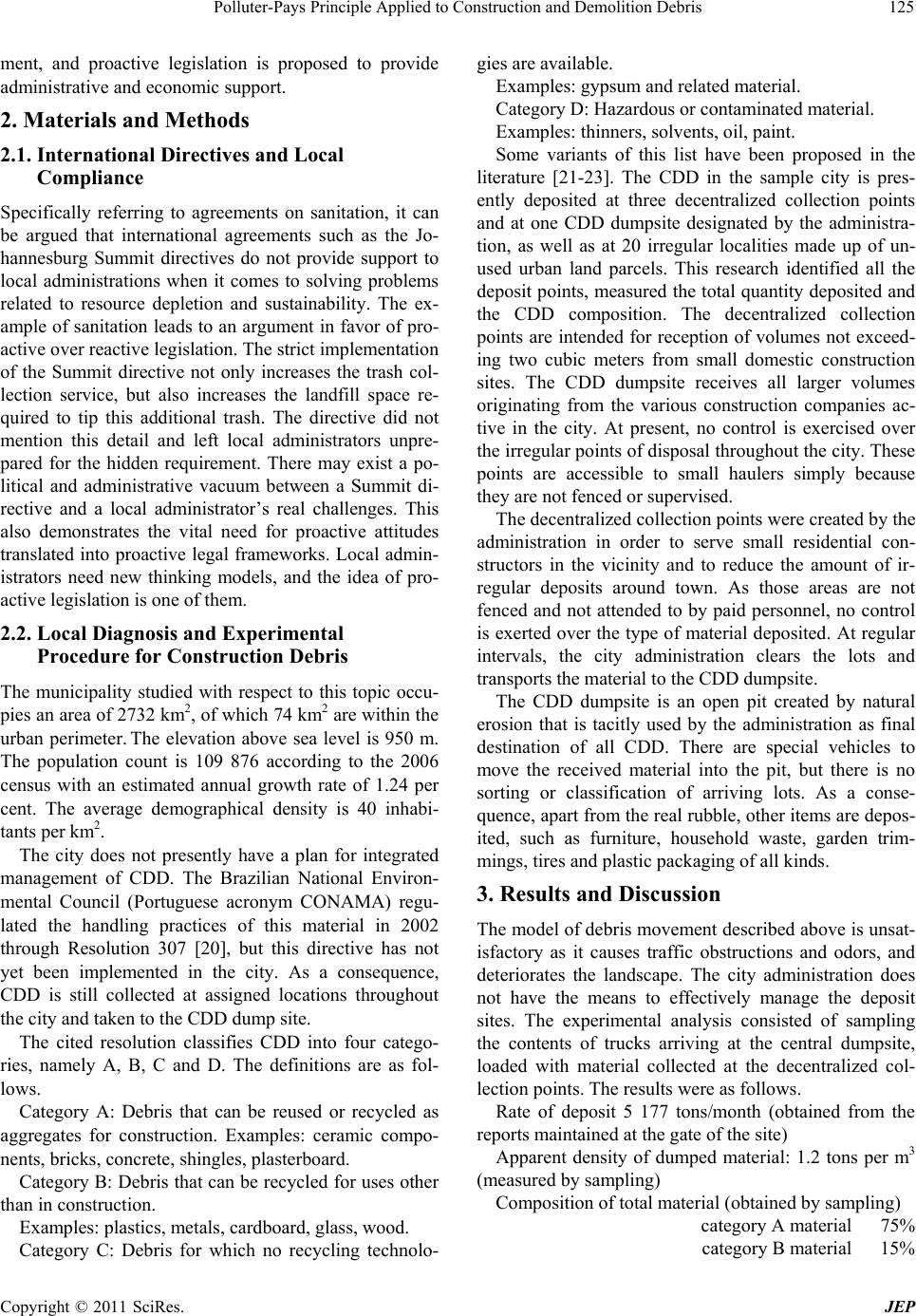 Polluter-Pays Principle Applied to Construction and Demolition Debris125 ment, and proactive legislation is proposed to provide administrative and economic support. 2. Materials and Methods 2.1. International Directives and Local Compliance Specifically referring to agreements on sanitation, it can be argued that international agreements such as the Jo- hannesburg Summit directives do not provide support to local administrations when it comes to solving problems related to resource depletion and sustainability. The ex- ample of sanitation leads to an argument in favor of pro- active over reactive legislation. The strict implementation of the Summit directive not only increases the trash col- lection service, but also increases the landfill space re- quired to tip this additional trash. The directive did not mention this detail and left local administrators unpre- pared for the hidden requirement. There may exist a po- litical and administrative vacuum between a Summit di- rective and a local administrator’s real challenges. This also demonstrates the vital need for proactive attitudes translated into proactive legal frameworks. Local admin- istrators need new thinking models, and the idea of pro- active legislation is one of them. 2.2. Local Diagnosis and Experimental Procedure for Construction Debris The municipality studied with respect to this topic occu- pies an area of 2732 km2, of which 74 km2 are within the urban perimeter. The elevation above sea level is 950 m. The population count is 109 876 according to the 2006 census with an estimated annual growth rate of 1.24 per cent. The average demographical density is 40 inhabi- tants per km2. The city does not presently have a plan for integrated management of CDD. The Brazilian National Environ- mental Council (Portuguese acronym CONAMA) regu- lated the handling practices of this material in 2002 through Resolution 307 [20], but this directive has not yet been implemented in the city. As a consequence, CDD is still collected at assigned locations throughout the city and taken to the CDD dump site. The cited resolution classifies CDD into four catego- ries, namely A, B, C and D. The definitions are as fol- lows. Category A: Debris that can be reused or recycled as aggregates for construction. Examples: ceramic compo- nents, bricks, concrete, shingles, plasterboard. Category B: Debris that can be recycled for uses other than in construction. Examples: plastics, metals, cardboard, glass, wood. Category C: Debris for which no recycling technolo- gies are available. Examples: gypsum and related material. Category D: Hazardous or contaminated material. Examples: thinners, solven ts, oil, paint. Some variants of this list have been proposed in the literature [21-23]. The CDD in the sample city is pres- ently deposited at three decentralized collection points and at one CDD dumpsite designated by the administra- tion, as well as at 20 irregular localities made up of un- used urban land parcels. This research identified all the deposit points, measured the total quantity deposited and the CDD composition. The decentralized collection points are intended for reception of volumes not exceed- ing two cubic meters from small domestic construction sites. The CDD dumpsite receives all larger volumes originating from the various construction companies ac- tive in the city. At present, no control is exercised over the irregular points of disposal throu ghout the city. These points are accessible to small haulers simply because they are not fenced or supervised. The decentralized collection points were created by the administration in order to serve small residential con- structors in the vicinity and to reduce the amount of ir- regular deposits around town. As those areas are not fenced and not attended to by paid personnel, no control is exerted over the type of material deposited. At regular intervals, the city administration clears the lots and transports the material to the CDD dumpsite. The CDD dumpsite is an open pit created by natural erosion that is tacitly used by the administration as final destination of all CDD. There are special vehicles to move the received material into the pit, but there is no sorting or classification of arriving lots. As a conse- quence, apart from the real rubble, other items are depos- ited, such as furniture, household waste, garden trim- mings, tires and plastic packaging of all kinds. 3. Results and Discussion The model of debris movement described above is unsat- isfactory as it causes traffic obstructions and odors, and deteriorates the landscape. The city administration does not have the means to effectively manage the deposit sites. The experimental analysis consisted of sampling the contents of trucks arriving at the central dumpsite, loaded with material collected at the decentralized col- lection points. The results were as follows. Rate of deposit 5 177 tons/month (obtained from the reports maintained at the gate of the site) Apparent density of dumped material: 1.2 tons per m3 (measured b y sampli ng) Composition of total material (obtained by sampling) category A material 75% category B material 15% Copyright © 2011 SciRes. JEP 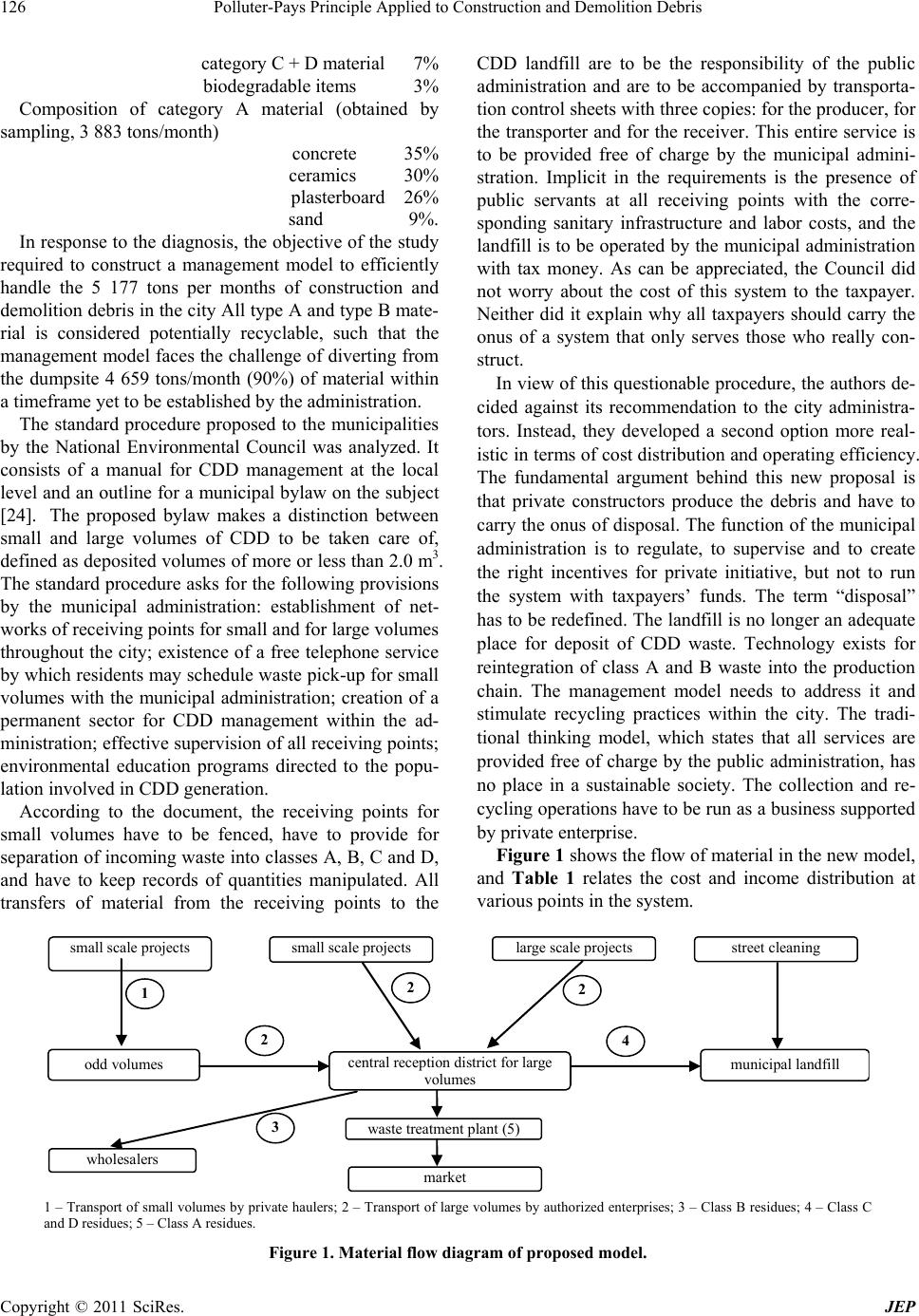 Polluter-Pays Principle Applied to Construction and Demolition Debris Copyright © 2011 SciRes. JEP 126 category C + D material 7% biodegradable items 3% Composition of category A material (obtained by sampling, 3 883 tons/month) concrete 35% ceramics 30% plasterboard 26% sand 9%. In response to the diagnosis, the objective of the study required to construct a management model to efficiently handle the 5 177 tons per months of construction and demolition debris in the city All type A and type B mate- rial is considered potentially recyclable, such that the management model faces the challenge of diverting from the dumpsite 4 659 tons/month (90%) of material within a timeframe yet to be established by the administratio n. The standard procedure proposed to the municipalities by the National Environmental Council was analyzed. It consists of a manual for CDD management at the local level and an outline fo r a municipal bylaw on the subject [24]. The proposed bylaw makes a distinction between small and large volumes of CDD to be taken care of, defined as deposited volumes of more or less than 2.0 m3. The standard procedure asks for the following provisions by the municipal administration: establishment of net- works of receiving points for small and for large volumes throughout the city; existence of a free telephone service by which residents may schedule waste pick-up for small volumes with the municipal administration; creation of a permanent sector for CDD management within the ad- ministration; effective supervision of all receiving points; environmental education programs directed to the popu- lation involved in CDD generation. According to the document, the receiving points for small volumes have to be fenced, have to provide for separation of incoming waste into classes A, B, C and D, and have to keep records of quantities manipulated. All transfers of material from the receiving points to the CDD landfill are to be the responsibility of the public administration and are to be accompanied by transporta- tion control sheets with three copies: for the producer, for the transporter and for the receiver. This entire service is to be provided free of charge by the municipal admini- stration. Implicit in the requirements is the presence of public servants at all receiving points with the corre- sponding sanitary infrastructure and labor costs, and the landfill is to be operated by the municipal administration with tax money. As can be appreciated, the Council did not worry about the cost of this system to the taxpayer. Neither did it explain why all taxpayers should carry the onus of a system that only serves those who really con- struct. In view of this questionable procedure, the authors de- cided against its recommendation to the city administra- tors. Instead, they developed a second option more real- istic in terms of cost distribution and operating efficiency. The fundamental argument behind this new proposal is that private constructors produce the debris and have to carry the onus of disposal. The function of the municipal administration is to regulate, to supervise and to create the right incentives for private initiative, but not to run the system with taxpayers’ funds. The term “disposal” has to be redefined. The lan dfill is no longer an adequate place for deposit of CDD waste. Technology exists for reintegration of class A and B waste into the production chain. The management model needs to address it and stimulate recycling practices within the city. The tradi- tional thinking model, which states that all services are provided free of charge by the public administration, has no place in a sustainable society. The collection and re- cycling operations have to be run as a business supported by private enterprise. Figure 1 shows the flow of material in the new model, and Table 1 relates the cost and income distribution at various points in the system. small scale projects odd volumes small scale projects large sc a l e p rojects cent ral reception district for large volumes waste treatment plant (5) 1 market str eet clean ing wholesalers muni cipal landfill 2 22 4 3 1 – Transport of small volumes by private haulers; 2 – Transport of large volumes by authorized enterprises; 3 – Class B residues; 4 – Class C and D residues; 5 – Class A residues. Figure 1. Material flow diagram of proposed model. 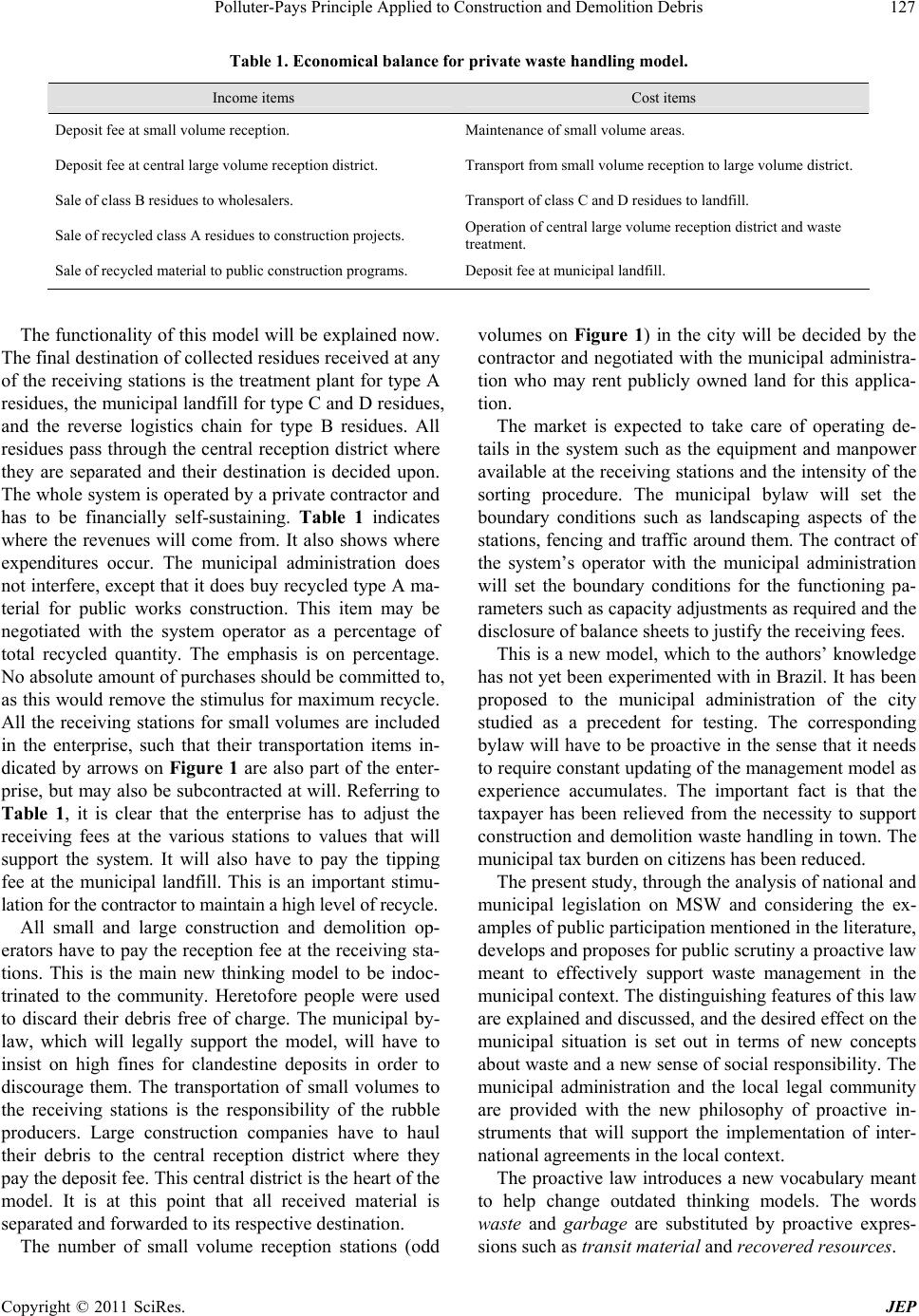 Polluter-Pays Principle Applied to Construction and Demolition Debris127 Table 1. Economical balance for private waste handling model. Income items Cost items Deposit fee at small volume reception. Maintenance of small volume areas. Deposit fee at central large volume reception district. Transport from small volume reception to large volume district. Sale of class B residues to wholesalers. Transport of class C and D residues to landfill. Sale of recycled class A residues to construction projects. Operation of central large volume reception district and waste treatment. Sale of recycled material to public construction programs. Deposit fee at municipal landfill. The functionality of th is model will be explained now. The final destination of collected residues received at any of the receiving stations is the treatment plant for type A residues, the municipal landfill for type C and D residues, and the reverse logistics chain for type B residues. All residues pass through the central reception district where they are separated and their destination is decided upon. The whole system is operated by a private contractor and has to be financially self-sustaining. Table 1 indicates where the revenues will come from. It also shows where expenditures occur. The municipal administration does not interfere, except that it does buy recycled type A ma- terial for public works construction. This item may be negotiated with the system operator as a percentage of total recycled quantity. The emphasis is on percentage. No absolute amount of purchases should be committed to, as this would remove the stimulus for maximum recycle. All the receiving stations for small volumes are included in the enterprise, such that their transportation items in- dicated by arrows on Figure 1 are also part of the enter- prise, but may also be subcontracted at will. Referring to Table 1, it is clear that the enterprise has to adjust the receiving fees at the various stations to values that will support the system. It will also have to pay the tipping fee at the municipal landfill. This is an important stimu- lation for the contractor to maintain a high level of recycle. All small and large construction and demolition op- erators have to pay the reception fee at the receiving sta- tions. This is the main new thinking model to be indoc- trinated to the community. Heretofore people were used to discard their debris free of charge. The municipal by- law, which will legally support the model, will have to insist on high fines for clandestine deposits in order to discourage them. The transportation of small volumes to the receiving stations is the responsibility of the rubble producers. Large construction companies have to haul their debris to the central reception district where they pay the deposit fee. This central district is the heart of the model. It is at this point that all received material is separated and forward ed to its respective destination. The number of small volume reception stations (odd volumes on Figure 1) in the city will be decided by the contractor and negotiated with the municipal administra- tion who may rent publicly owned land for this applica- tion. The market is expected to take care of operating de- tails in the system such as the equipment and manpower available at the receiving stations and the intensity of the sorting procedure. The municipal bylaw will set the boundary conditions such as landscaping aspects of the stations, fencing and traffic around them. The contract of the system’s operator with the municipal administration will set the boundary conditions for the functioning pa- rameters such as capacity adjustments as required and the disclosure of balance sheets to justify the receiving fees. This is a new model, which to the authors’ knowledge has not yet been experimented with in Brazil. It has been proposed to the municipal administration of the city studied as a precedent for testing. The corresponding bylaw will have to be proactive in the sense that it needs to require constant updating of the management model as experience accumulates. The important fact is that the taxpayer has been relieved from the necessity to support construction and demolition waste handling in town. The municipal tax burden on citizens has been reduce d. The present study, through the analysis of natio nal and municipal legislation on MSW and considering the ex- amples of public participation mention ed in th e literature, develops and propo ses for public scru tin y a proactiv e law meant to effectively support waste management in the municipal context. The distinguishing features of this law are explained and discussed, and the desired effect on the municipal situation is set out in terms of new concepts about waste and a new sense of social responsib ility. The municipal administration and the local legal community are provided with the new philosophy of proactive in- struments that will support the implementation of inter- national agreements in th e local context. The proactive law introduces a new vocabulary meant to help change outdated thinking models. The words waste and garbag e are substituted by proactive expres- sions such as transit material and recovered resources. Copyright © 2011 SciRes. JEP 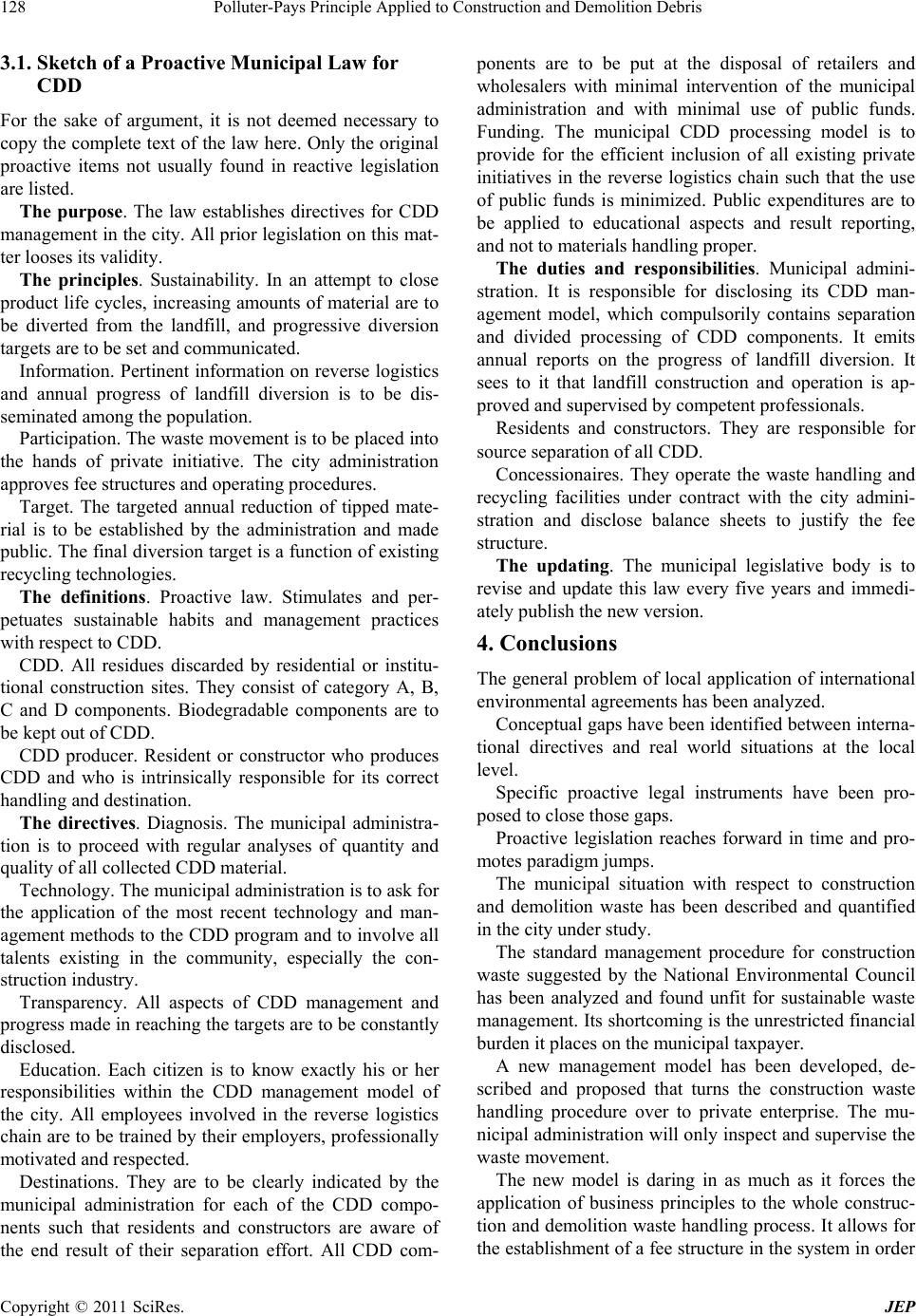 Polluter-Pays Principle Applied to Construction and Demolition Debris 128 3.1. Sketch of a Proactive Municipal Law for CDD For the sake of argument, it is not deemed necessary to copy the complete text of the law here. On ly the original proactive items not usually found in reactive legislation are listed. The purpose. The law establishes directives for CDD management in the city. All prior legislatio n on this mat- ter looses its validity. The principles. Sustainability. In an attempt to close product life cycles, increasing amounts of material are to be diverted from the landfill, and progressive diversion targets are to be set and communicated. Information. Pertinent information on reverse logistics and annual progress of landfill diversion is to be dis- seminated among the population. Participation. The waste movement is to be placed into the hands of private initiative. The city administration approves fee structures and operating procedures. Target. The targeted annual reduction of tipped mate- rial is to be established by the administration and made public. The final diversion target is a fun ction of existing recycling technolog ies. The definitions. Proactive law. Stimulates and per- petuates sustainable habits and management practices with respect to CDD. CDD. All residues discarded by residential or institu- tional construction sites. They consist of category A, B, C and D components. Biodegradable components are to be kept out o f CDD. CDD producer. Resident or constructor who produces CDD and who is intrinsically responsible for its correct handling an d destination. The directives. Diagnosis. The municipal administra- tion is to proceed with regular analyses of quantity and quality of all collected CDD material. Technology. The municipal administration is to ask for the application of the most recent technology and man- agement methods to the CDD program and to involve all talents existing in the community, especially the con- struction industry. Transparency. All aspects of CDD management and progress made in reaching the targ ets are to be con stantly disclosed. Education. Each citizen is to know exactly his or her responsibilities within the CDD management model of the city. All employees involved in the reverse logistics chain are to be trained by their employers, professionally motivated and respected. Destinations. They are to be clearly indicated by the municipal administration for each of the CDD compo- nents such that residents and constructors are aware of the end result of their separation effort. All CDD com- ponents are to be put at the disposal of retailers and wholesalers with minimal intervention of the municipal administration and with minimal use of public funds. Funding. The municipal CDD processing model is to provide for the efficient inclusion of all existing private initiatives in the reverse logistics chain such that the use of public funds is minimized. Public expenditures are to be applied to educational aspects and result reporting, and not to materials handling prop er. The duties and responsibilities. Municipal admini- stration. It is responsible for disclosing its CDD man- agement model, which compulsorily contains separation and divided processing of CDD components. It emits annual reports on the progress of landfill diversion. It sees to it that landfill construction and operation is ap- proved and supervised by competent professionals. Residents and constructors. They are responsible for source separation of all CDD. Concessionaires. They operate the waste handling and recycling facilities under contract with the city admini- stration and disclose balance sheets to justify the fee structure. The updating. The municipal legislative body is to revise and update this law every five years and immedi- ately publish the new version. 4. Conclusions The general problem of local application of international environmental agreements has been analyzed. Conceptual gaps have been identified between interna- tional directives and real world situations at the local level. Specific proactive legal instruments have been pro- posed to close those gaps. Proactive legislation reaches forward in time and pro- motes paradigm jumps. The municipal situation with respect to construction and demolition waste has been described and quantified in the city under study. The standard management procedure for construction waste suggested by the National Environmental Council has been analyzed and found unfit for sustainable waste management. Its shortcoming is the unrestricted financial burden it places on the municipal taxpayer. A new management model has been developed, de- scribed and proposed that turns the construction waste handling procedure over to private enterprise. The mu- nicipal administration will only in spect and supervise the waste movement. The new model is daring in as much as it forces the application of business principles to the whole construc- tion and demolition waste handling process. It allows for the establishment of a fee structure in the system in order Copyright © 2011 SciRes. JEP 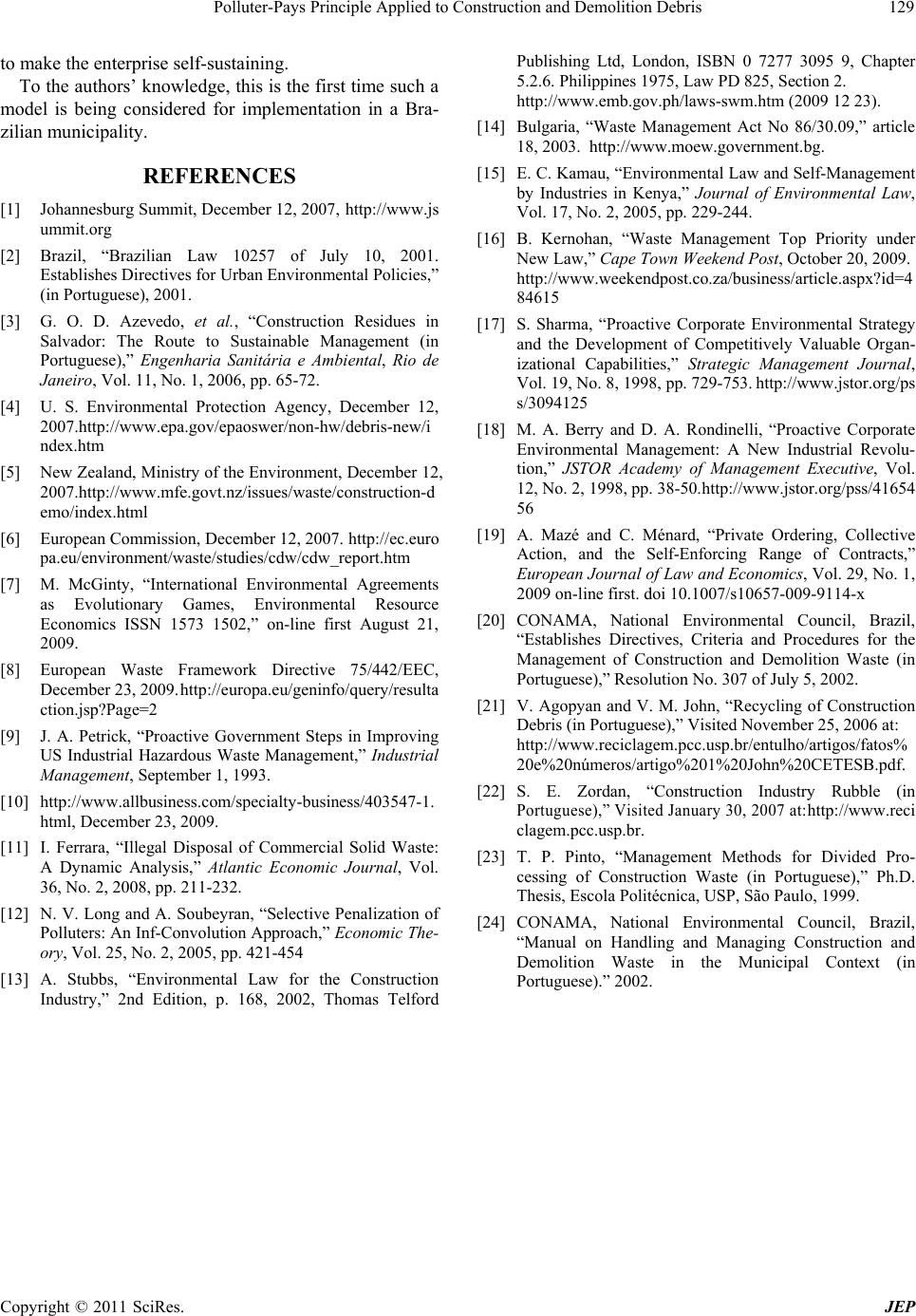 Polluter-Pays Principle Applied to Construction and Demolition Debris Copyright © 2011 SciRes. JEP 129 to make the enterprise self-sustaining. To the authors’ knowledge, this is the first time such a model is being considered for implementation in a Bra- zilian municipality. REFERENCES [1] Johannesburg Summit, December 12, 2007,http://www.js ummit.org [2] Brazil, “Brazilian Law 10257 of July 10, 2001. Establishes Directives for Urban Environmental Policies,” (in Portuguese), 2001. [3] G. O. D. Azevedo, et al., “Construction Residues in Salvador: The Route to Sustainable Management (in Portuguese),” Engenharia Sanitária e Ambiental, Rio de Janeiro, Vol. 11, No. 1, 2006, pp. 65-72. [4] U. S. Environmental Protection Agency, December 12, 2007.http://www.epa.gov/epaoswer/non-hw/debris-new/i ndex.htm [5] New Zealand, Ministry of the Environment, December 12, 2007.http://www.mfe.govt.nz/issues/waste/construction-d emo/index.html [6] European Commission, December 12, 2007.http://ec.euro pa.eu/environment/waste/studies/cdw/cdw_report.htm [7] M. McGinty, “International Environmental Agreements as Evolutionary Games, Environmental Resource Economics ISSN 1573 1502,” on-line first August 21, 2009. [8] European Waste Framework Directive 75/442/EEC, December 23, 2009.http://europa.eu/geninfo/query/resulta ction.jsp?Page=2 [9] J. A. Petrick, “Proactive Government Steps in Improving US Industrial Hazardous Waste Management,” Industrial Management, September 1, 1993. [10] http://www.allbusiness.com/specialty-business/403547-1. html, December 23, 2009. [11] I. Ferrara, “Illegal Disposal of Commercial Solid Waste: A Dynamic Analysis,” Atlantic Economic Journal, Vol. 36, No. 2, 2008, pp. 211-232. [12] N. V. Long and A. Soubeyran, “Selective Penalization of Polluters: An Inf-Convolution Approach,” Economic The- ory, Vol. 25, No. 2, 2005, pp. 421-454 [13] A. Stubbs, “Environmental Law for the Construction Industry,” 2nd Edition, p. 168, 2002, Thomas Telford Publishing Ltd, London, ISBN 0 7277 3095 9, Chapter 5.2.6. Philippines 1975, Law PD 825, Section 2. http://www.emb.gov.ph/laws-swm.htm (2009 12 23). [14] Bulgaria, “Waste Management Act No 86/30.09,” article 18, 2003. http://www.moew.government.bg. [15] E. C. Kamau, “Environmental Law and Self-Management by Industries in Kenya,” Journal of Environmental Law, Vol. 17, No. 2, 2005, pp. 229-244. [16] B. Kernohan, “Waste Management Top Priority under New Law,” Cape Town Weekend Post, October 20, 2009. http://www.weekendpost.co.za/business/article.aspx?id=4 84615 [17] S. Sharma, “Proactive Corporate Environmental Strategy and the Development of Competitively Valuable Organ- izational Capabilities,” Strategic Management Journal, Vol. 19, No. 8, 1998, pp. 729-753.http://www.jstor.org/ps s/3094125 [18] M. A. Berry and D. A. Rondinelli, “Proactive Corporate Environmental Management: A New Industrial Revolu- tion,” JSTOR Academy of Management Executive, Vol. 12, No. 2, 1998, pp. 38-50.http://www.jstor.org/pss/41654 56 [19] A. Mazé and C. Ménard, “Private Ordering, Collective Action, and the Self-Enforcing Range of Contracts,” European Journal of Law and Economics, Vol. 29, No. 1, 2009 on-line first. doi 10.1007/s10657-009-9114-x [20] CONAMA, National Environmental Council, Brazil, “Establishes Directives, Criteria and Procedures for the Management of Construction and Demolition Waste (in Portuguese),” Resolution No. 307 of July 5, 2002. [21] V. Agopyan and V. M. John, “Recycling of Construction Debris (in Portuguese),” Visited November 25, 2006 at: http://www.reciclagem.pcc.usp.br/entulho/artigos/fatos% 20e%20números/artigo%201%20John%20CETESB.pdf. [22] S. E. Zordan, “Construction Industry Rubble (in Portuguese),” Visited Janua ry 30, 2007 at: http://www.reci clagem.pcc.usp.br. [23] T. P. Pinto, “Management Methods for Divided Pro- cessing of Construction Waste (in Portuguese),” Ph.D. Thesis, Escola Politécnica, USP, São Paulo, 1999. [24] CONAMA, National Environmental Council, Brazil, “Manual on Handling and Managing Construction and Demolition Waste in the Municipal Context (in Portuguese).” 2002. |

